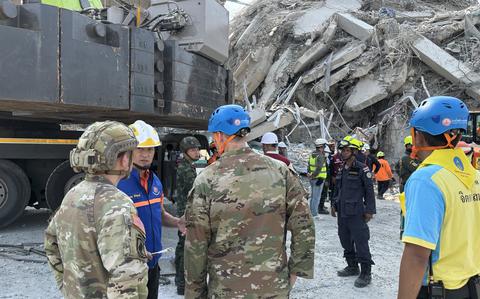US Military Assistance to Thailand and Financial Aid for Myanmar After Earthquake Catastrophe
In the wake of a devastating 7.7-magnitude earthquake that struck on Friday, the United States has mobilized military personnel to Thailand and pledged financial assistance to Myanmar to aid recovery efforts. This disaster has left cities ravaged and communities in dire need of support, with loss of life and infrastructure at an alarming scale.
The Catastrophe Unfolds: A Closer Look at the Damage
In Myanmar, particularly around the city of Mandalay, the earthquake has claimed a catastrophic toll: over 2,000 lives lost, with approximately 3,900 injured and around 270 people missing, as reported by The Associated Press. The devastation is palpable, with the stench of decay pervading the streets as rescue operations struggle against the odds.
Meanwhile, in Thailand's bustling capital, the death toll has reached 18, with 33 injuries recorded and 78 people unaccounted for, according to updates from Bangkok's city hall.
Immediate Response: US Military Support in Thailand
The U.S. Indo-Pacific Command wasted no time in deploying military assistance to coordinate relief efforts in Thailand, working alongside the Thai military and various first responders. Command spokesman Maj. Matthew Gregory indicated that U.S. forces are engaged in crucial tasks ranging from debris removal to personnel recovery.
While the specific number of personnel remains fluid, this contingent includes U.S. Army engineers, Navy Seabees, and K9 handlers, all equipped to tackle the challenges posed by the aftermath of the earthquake. "Specialized [search-and-rescue] personnel, engineers, and capabilities from around the Indo-Pacific are responding during this solemn time," Gregory said, emphasizing the U.S. commitment to aiding its ally during this crisis.
The Long Border: Myanmar-Thailand Relations
Myanmar and Thailand share a 1,500-mile border, a region increasingly affected by unrest. Myanmar has been embroiled in a civil conflict since a military coup in 2023, complicating relief efforts. The National Unity Government, the country’s government-in-exile, has announced a partial ceasefire to assist humanitarian aid endeavors, as detailed by the AP.
Despite the escalating situation, Major Gregory declined to comment on the possibility of U.S. military aid extending to Myanmar, focusing instead on the immediate needs in Thailand.
Financial Aid Flowing to Myanmar
In a bid to provide much-needed support, the U.S. Embassy in Myanmar has announced a commitment of $2 million in aid directed through local humanitarian organizations. This prompt reaction reflects an understanding of the urgent needs on the ground.
Additionally, a U.S. Agency for International Development (USAID) emergency response team is set to deploy to identify critical needs such as emergency shelter, food, medical assistance, and access to safe drinking water. These actions come amid significant scrutiny regarding U.S. foreign aid, especially after President Trump expressed intentions to cut jobs at USAID, a decision that Rep. Gregory Meeks described as "reckless" amidst rising influences from China and Russia, who are rapidly filling gaps with their own assistance to the region.
Global Responses: China and Russia Step In
In the aftermath of this tragedy, China has been quick to respond, dispatching two rescue teams and allocating 100 million yuan (approximately $13.7 million) for aid. Russia is also contributing, sending resources including aircraft, doctors, and search-and-rescue teams to assist in recovery efforts.
Conclusion: A Call for Global Solidarity
As the dust settles on this tragedy, it is clear that international solidarity and support are crucial for the recovery of both Thailand and Myanmar. With nations coming together to respond and offer aid, the road ahead will require coordination, patience, and resilience as communities begin to rebuild and heal from this profound disaster.
For more information, visit AP News and USAID for ongoing updates on international relief efforts.






